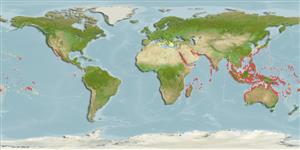Common names from other countries
Environment: milieu / climate zone / depth range / distribution range
Écologie
; profondeur 0 - 20 m (Ref. 348). Tropical
Distribution
Pays | Zones FAO | Écosystèmes | Occurrences | Introductions
Indo-West Pacific and the Mediterranean: from East Africa, to Melanesia; north to South China and Taiwan Province of China and south to Indonesia; south and eastern parts of the Mediterranean. Tropical to subtropical climates.
Length at first maturity / Taille / Poids / Âge
Maturity: Lm ? range ? - ? cm Max length : 12.0 cm SHL mâle / non sexé; (Ref. 348); common length : 8.0 cm mâle / non sexé; (Ref. 348)
Locally collected at low tide by coastal people when abundant (Ref. 348). Attached by their strong byssus to hard substrates where mud occurs, with the shell vertically disposed and the dorsal margin lying on the rock surface, or to the underside of ledges and boulders. Often in dense colonies (maximum recorded density of 870 individuals/m^2), sometimes forming mixed natural beds with Isognomon isognomum. Littoral and sublittoral (Ref. 348).
Life cycle and mating behavior
Maturité | Reproduction | Frai | Œufs | Fécondité | Larves
Members of the class Bivalvia are mostly gonochoric, some are protandric hermaphrodites. Life cycle: Embryos develop into free-swimming trocophore larvae, succeeded by the bivalve veliger, resembling a miniature clam.
Poutiers, J.M. 1998. (Ref. 348)
Statut dans la liste rouge de l'IUCN (Ref. 130435)
statut CITES (Ref. 108899)
Not Evaluated
Not Evaluated
Utilisations par l'homme
| FishSource |
Outils
Plus d'informations
Taille/Âge
Croissance
Longueur-poids
Longueur-longueur
Morphologie
Larves
Abondance
Sources Internet
Estimates based on models
Preferred temperature
(Ref.
115969): 22.1 - 29.3, mean 28.2 (based on 4092 cells).
Vulnérabilité
Low vulnerability (10 of 100).
Catégorie de prix
Unknown.
